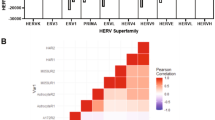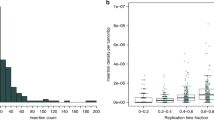Abstract
Human endogenous retroviruses (HERV) are remnants of exogenous retroviral infections, representing 8% of the human genome. Their regulation is based on the DNA methylation of promoters, the long terminal repeats (LTRs). Transcripts from HERV have been associated with cancers, but reports concerning HERV expression in colorectal cancer remain sporadic. Sixty-three patients with advanced stages of colorectal cancer were enrolled in this study. The expressions of HERV env gene, and HERV-H, -K, -R and -P LTRs and Alu, LINE-1 methylation levels, were investigated in the tumor, normal adjacent tissues, and, where possible, blood and plasmatic extracellular vesicles (EVs). Associations among HERV env expression, methylation status and clinical characteristics were evaluated. No differences were observed in HERV env gene expression levels among the clinical specimens, while Alu, LINE-1, HERV-H and -K LTRs were demethylated in the tumor compared to the normal adjacent tissues (p < 0.05).The HERV env gene was expressed in the EVs at of 54% (-H), 38% (-K), 31% (-R) patients. Association was not found between HERV env expression and LTR methylation, but significant higher expression of HERV-P and -R env was found in tumor tissues arising from the right colon. Our findings do not demonstrate significant overexpression of the studied HERV in colorectal cancer, but their association with tumor localization and specificity of the changes in DNA methylation of retroelements are shown. HERV sequences were packaged in the EVs and might be transferred from one cell to another.


Similar content being viewed by others
References
Liang Q, Ding J, Xu R, Xu Z, Zheng S (2009) Identification of a novel human endogenous retrovirus and promoter activity of its 5′ U3. Biochem Biophys Res Commun 382:468–472
Bannert N, Kurth R (2006) The evolutionary dynamics of human endogenous retroviral families. Annu Rev Genom Hum Genet 7:149–173
Yu HL, Zhao ZK, Zhu F (2013) The role of human endogenous retroviral long terminal repeat sequences in human cancer (review). Int J Mol Med 32:755–762
Villesen P, Aagaard L, Wiuf C, Pedersen FS (2004) Identification of endogenous retroviral reading frames in the human genome. Retrovirology 1:32
Bénit L, Dessen P, Heidmann T (2001) Identification, phylogeny, and evolution of retroviral elements based on their envelope genes. J Virol 75:11709–11719
Ruprecht K, Mayer J, Sauter M, Roemer K, Mueller-Lantzsch N (2008) Endogenous retroviruses and cancer. Cell Mol Life Sci 65:3366–3382
Schmitt K, Reichrath J, Roesch A, Meese E, Mayer J (2013) Transcriptional profiling of human endogenous retrovirus group HERV-K(HML-2) loci in melanoma. Genome Biol Evol 5:307–328
Wang-Johanning F, Li M, Esteva FJ, Hess KR, Yin B, Rycaj K, Plummer JB, Garza JG, Ambs S, Johanning GL (2014) Human endogenous retrovirus type K antibodies and mRNA as serum biomarkers of early-stage breast cancer. Int J Cancer 134:587–595
Wallace TA, Downey RF, Seufert CJ, Schetter A, Dorsey TH, Johnson CA, Goldman R, Loffredo CA, Yan P, Sullivan FJ, Giles FJ, Wang-Johanning F, Ambs S, Glynn SA (2014) Elevated HERV-K mRNA expression in PBMC is associated with a prostate cancer diagnosis particularly in older men and smokers. Carcinogenesis 35:2074–2083
Reis BS, Jungbluth AA, Frosina D, Holz M, Ritter E, Nakayama E, Ishida T, Obata Y, Carver B, Scher H, Scardino PT, Slovin S, Subudhi SK, Reuter VE, Savage C, Allison JP, Melamed J, Jäger E, Ritter G, Old LJ, Gnjatic S (2013) Prostate cancer progression correlates with increased humoral immune response to a human endogenous retrovirus GAG protein. Clin Cancer Res 19:6112–6125
Haupt S, Tisdale M, Vincendeau M, Clements MA, Gauthier DT, Lance R, Semmes OJ, Turqueti-Neves A, Noessner E, Leib-Mösch C, Greenwood AD (2011) Human endogenous retrovirus transcription profiles of the kidney and kidney-derived cell lines. J Gen Virol 92:2356–2366
Pichon JP, Bonnaud B, Cleuziat P, Mallet F (2006) Multiplex degenerate PCR coupled with an oligo sorbent array for human endogenous retrovirus expression profiling. Nucleic Acids Res 34:e46
Stauffer Y, Theiler G, Sperisen P, Lebedev Y, Jongeneel CV (2004) Digital expression profiles of human endogenous retroviral families in normal and cancerous tissues. Cancer Immun 4:2
Shen H, Laird PW (2013) Interplay between the cancer genome and epigenome. Cell 153:38–55
Jones PA, Baylin SB (2002) The fundamental role of epigenetic events in cancer. Nat Rev Genet 3:415–428
Ogino S, Nosho K, Kirkner GJ, Kawasaki T, Chan AT, Schernhammer ES, Giovannucci EL, Fuchs CS (2008) A cohort study of tumoral LINE-1 hypomethylation and prognosis in colon cancer. J Natl Cancer Inst 100:1734–1738
Swets M, Zaalberg A, Boot A, van Wezel T, Frouws MA, Bastiaannet E, Gelderblom H, van de Velde CJ, Kuppen PJ (2016) Tumor LINE-1 methylation level in association with survival of patients with stage II colon cancer. Int J Mol Sci. https://doi.org/10.3390/ijms18010036
Gimenez J, Montgiraud C, Pichon JP, Bonnaud B, Arsac M, Ruel K, Bouton O, Mallet F (2010) Custom human endogenous retroviruses dedicated microarray identifies self-induced HERV-W family elements reactivated in testicular cancer upon methylation control. Nucleic Acids Res 38:2229–2246
Liang Q, Xu Z, Xu R, Wu L, Zheng S (2012) Expression patterns of non-coding spliced transcripts from human endogenous retrovirus HERV-H elements in colon cancer. PLoS ONE 7:e29950
Garnier D, Magnus N, Lee TH, Bentley V, Meehan B, Milsom C, Montermini L, Kislinger T, Rak J (2012) Cancer cells induced to express mesenchymal phenotype release exosome-like extracellular vesicles carrying tissue factor. J Biol Chem 287:43565–43572
Pergoli L, Favero C, Pfeiffer RM, Tarantini L, Calista D, Cavalleri T, Angelici L, Consonni D, Bertazzi PA, Pesatori AC, Landi MT, Bollati V (2014) Blood DNA methylation, nevi number, and the risk of melanoma. Melanoma Res 24:480–487
Wang H, Yang B, Geng T, Li B, Dai P, Chen C (2015) Tissue-specific selection of optimal reference genes for expression analysis of anti-cancer drug-related genes in tumor samples using quantitative real-time RT-PCR. Exp Mol Pathol 98:375–381
Rooney MS, Shukla SA, Wu CJ, Getz G, Hacohen N (2015) Molecular and genetic properties of tumors associated with local immune cytolytic activity. Cell 160:48–61
Lee SH, Kang YJ, Jo JO, Ock MS, Baek KW, Eo J, Lee WJ, Choi YH, Kim WJ, Leem SH, Kim HS, Cha HJ (2014) Elevation of human ERV3-1 env protein expression in colorectal cancer. J Clin Pathol 67:840–844
Ahn K, Kim HS (2009) Structural and quantitative expression analyses of HERV gene family in human tissues. Mol Cells 28:99–103
Alves PM, Lévy N, Stevenson BJ, Bouzourene H, Theiler G, Bricard G, Viatte S, Ayyoub M, Vuilleumier H, Givel JC, Rimoldi D, Speiser DE, Jongeneel CV, Romero PJ, Lévy F (2008) Identification of tumor-associated antigens by large-scale analysis of genes expressed in human colorectal cancer. Cancer Immun 8:11
Kim HS, Ahn K, Kim DS (2008) Quantitative expression of the HERV-W env gene in human tissues. Arch Virol 153:1587–1591
Pérot P, Mullins CS, Naville M, Bressan C, Hühns M, Gock M, Kühn F, Volff JN, Trillet-Lenoir V, Linnebacher M, Mallet F (2015) Expression of young HERV-H loci in the course of colorectal carcinoma and correlation with molecular subtypes. Oncotarget 6:40095–40111
Serafino A, Balestrieri E, Pierimarchi P, Matteucci C, Moroni G, Oricchio E, Rasi G, Mastino A, Spadafora C, Garaci E, Vallebona PS (2009) The activation of human endogenous retrovirus K (HERV-K) is implicated in melanoma cell malignant transformation. Exp Cell Res 315:849–862
Balestrieri E, Pica F, Matteucci C, Zenobi R, Sorrentino R, Argaw-Denboba A, Cipriani C, Bucci I, Sinibaldi-Vallebona P (2015) Transcriptional activity of human endogenous retroviruses in human peripheral blood mononuclear cells. Biomed Res Int 2015:164529
Gallois C, Pernot S, Zaanan A, Taieb J (2018) Colorectal cancer: why does side matter? Drugs 78:789–798
Baran B, Mert Ozupek N, Yerli Tetik N, Acar E, Bekcioglu O, Baskin Y (2018) Difference between left-sided and right-sided colorectal cancer: a focused review of literature. Gastroenterol Res 11:264–273
Network CGA (2012) Comprehensive molecular characterization of human colon and rectal cancer. Nature 487:330–337
Fearon ER, Vogelstein B (1990) A genetic model for colorectal tumorigenesis. Cell 61:759–767
Worthley DL, Leggett BA (2010) Colorectal cancer: molecular features and clinical opportunities. Clin Biochem Rev 31:31–38
Toyota M, Ahuja N, Ohe-Toyota M, Herman JG, Baylin SB, Issa JP (1999) CpG island methylator phenotype in colorectal cancer. Proc Natl Acad Sci U S A 96:8681–8686
Weisenberger DJ, Siegmund KD, Campan M, Young J, Long TI, Faasse MA, Kang GH, Widschwendter M, Weener D, Buchanan D, Koh H, Simms L, Barker M, Leggett B, Levine J, Kim M, French AJ, Thibodeau SN, Jass J, Haile R, Laird PW (2006) CpG island methylator phenotype underlies sporadic microsatellite instability and is tightly associated with BRAF mutation in colorectal cancer. Nat Genet 38:787–793
Balaj L, Lessard R, Dai L, Cho YJ, Pomeroy SL, Breakefield XO, Skog J (2011) Tumour microvesicles contain retrotransposon elements and amplified oncogene sequences. Nat Commun 2:180
Tyagi R, Li W, Parades D, Bianchet MA, Nath A (2017) Inhibition of human endogenous retrovirus-K by antiretroviral drugs. Retrovirology 14:21
MacGowan DJ, Scelsa SN, Imperato TE, Liu KN, Baron P, Polsky B (2007) A controlled study of reverse transcriptase in serum and CSF of HIV-negative patients with ALS. Neurology 68:1944–1946
Montesion M, Williams ZH, Subramanian RP, Kuperwasser C, Coffin JM (2018) Promoter expression of HERV-K (HML-2) provirus-derived sequences is related to LTR sequence variation and polymorphic transcription factor binding sites. Retrovirology 15:57
Florl AR, Lower R, Schmitz-Drager BJ, Schulz WA (1999) DNA methylation and expression of LINE-1 and HERV-K provirus sequences in urothelial and renal cell carcinomas. Br J Cancer 80:1312–1321
Hu L, Uzhameckis D, Hedborg F, Blomberg J (2016) Dynamic and selective HERV RNA expression in neuroblastoma cells subjected to variation in oxygen tension and demethylation. APMIS 124:140–149
Ashktorab H, Smoot DT, Farzanmehr H, Fidelia-Lambert M, Momen B, Hylind L, Iacosozio-Dononue C, Carethers JM, Goel A, Boland CR, Giardiello FM (2005) Clinicopathological features and microsatellite instability (MSI) in colorectal cancers from African Americans. Int J Cancer 116:914–919
Nayani R, Ashktorab H, Brim H, Laiyemo AO (2015) Genetic basis for colorectal cancer disparities. Curr Colorectal Cancer Rep 11:408–413
Funding
The study was supported by the Italian Ministry of University—PRIN 2015 to Pasquale Ferrante; Contract Grant Number 2015w729wh and by the University of Milan—Piano Sostegno alla Ricerca (PSR) 2017 and 2018, to Serena Delbue.
Author information
Authors and Affiliations
Corresponding author
Ethics declarations
Conflict of interest
The authors declare that they have no actual or potential conflict of interests.
Ethics and consent
The patients included in the study signed the informed consent after Institutional Ethics Committee approval was obtained (Ethical Committee Istituto Clinico Città Studi, Ospedale Maggiore Policlinico Milano, Protocol Number 683_2017bis). The study was performed in accordance with the Declaration of Helsinki.
Additional information
Edited by Matthias J. Reddehase.
Publisher's Note
Springer Nature remains neutral with regard to jurisdictional claims in published maps and institutional affiliations.
Electronic supplementary material
Below is the link to the electronic supplementary material.
Rights and permissions
About this article
Cite this article
Dolci, M., Favero, C., Tarantini, L. et al. Human endogenous retroviruses env gene expression and long terminal repeat methylation in colorectal cancer patients. Med Microbiol Immunol 209, 189–199 (2020). https://doi.org/10.1007/s00430-020-00662-6
Received:
Accepted:
Published:
Issue Date:
DOI: https://doi.org/10.1007/s00430-020-00662-6




